 |
| The Independent Traveler's Newsletter PAGE THREE |
 |
| The Independent Traveler's Newsletter PAGE THREE |
Happily 'Lost' in the French countryside continued . . . 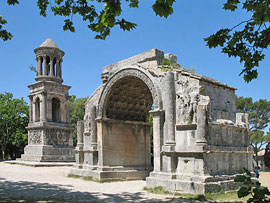 Not on the list of Most Beautiful Villages, but a town not to miss, is nearby St-Rémy-de-Provence; enjoy lunch in one of its many restaurants, wander the smaller streets of this charming town, and perhaps come upon the house where Nostradamus (French physician Michel de Nostradame) was born on December 14, 1503. We did! It was a pleasant surprise. A most interesting archeological site is Glanum, on the south edge of St-Rémy. Glanum was a fortified town founded by Celto-Ligurian people in the 6th century BC, overtaken by the Romans in 27 BC, but by 260 AD it was abandoned. [The photo at right is the Roman Arch in Glanum.] From June 17 to September 17 there will be an exposition of photographs taken by Michel Elsenlohr of the ancient archeological site of Palmyra and the Syrian cities of Aleppo and Damascus. The program will be offered both at Glanum and the Hôtel de Sade in St-Rémy.  Farther to the southeast is the hilltop commune of Ménerbes (Vaucluse), made famous by Peter Mayle's best selling book, A Year in Provence. It is a delightful tiny village with a population of about 1100 inhabitants and many very narrow streets better suited to horse and buggy than today's automobiles. But, it's delightful nonetheless for a brief visit. Also in the Vaucluse is the artist village of Lourmarin surrounded by olive groves and vineyards and boasting a fine Romanesque church and a grand castle. Also noteworthy, it is the final resting place of Albert Camus. For accommodations in the Vaucluse, Château Juvenal, Le Pavillon de Galon and Château Talaud are all lovely bed and breakfasts ~ Juvenal and Talaud offer weekly rental apartments, and Galon will rent "One Week, One Wing". The owners each produce wine from their own vineyards, and Château Juvenal makes luscious olive oil as well!  The Var département is
home to several members of Les
Plus Beaux Villages de France, one of which is Seillans,
a
perched village with a view of the plain between Cannes and
Saint-Raphaël. Its
houses are on terraced hillsides, fountains dot the village, and it was
a favorite location of painter Max Ernst. Visit the highest
village in the Var, Bargème,
at 1097 meters, that has a 12th century castle that was destroyed
during the Wars of Religion, a terraced hillside below the ruins of the
castle, and unobstructed views of the valley below.
The Var département is
home to several members of Les
Plus Beaux Villages de France, one of which is Seillans,
a
perched village with a view of the plain between Cannes and
Saint-Raphaël. Its
houses are on terraced hillsides, fountains dot the village, and it was
a favorite location of painter Max Ernst. Visit the highest
village in the Var, Bargème,
at 1097 meters, that has a 12th century castle that was destroyed
during the Wars of Religion, a terraced hillside below the ruins of the
castle, and unobstructed views of the valley below.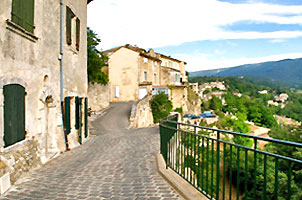 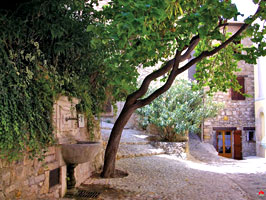 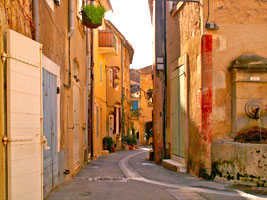 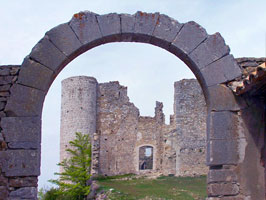
Mènerbes
Seillans
Lourmarin
Bargème
We
would like to comment at this juncture about the preservation of
ancient ruins in France.
As you explore the country you will come upon a significant number of ruins from Gallo-Romans times. It is common knowledge that there are more well-preserved sites and structures from the Roman Empire in France than anywhere else in Europe. You will see that the French have taken great care over the centuries to preserve, restore and protect its archeological history. Of course, it isn't only Roman ruins but the dwellings and sites of Cro-Magnon man going back 35,000 years ago to the standing stones and burial mounds of Neolithic man from about 4000 BC. France is the most visited country in the world, and by preserving its ancient history ~ from major structures such as the Pont du Gard to the smallest artifacts in tiny hamlets countrywide ~ people from all over the world are given the opportunity to share these treasures. 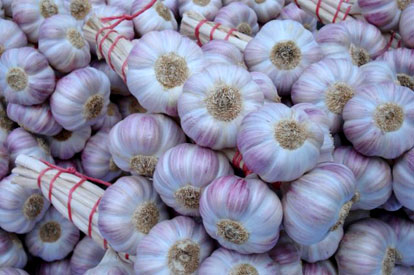 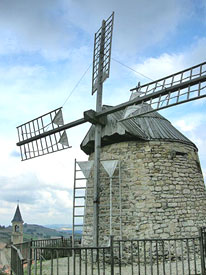  Traveling westward, you will enter the Tarn département to find one of its four members of the association worth every minute you can spend there. It is Lautrec, about an hour east of Toulouse, and a place like no other. Cozy little streets, a fine place, unique restaurants, a museum taking you back to the time of Charlemagne who built a church below the village walls, a 16th century working mill at the top of the hill [photo right], and a 14th century market square are all pleasant discoveries in this village of fewer than 1700 inhabitants. And, Lautrec is renowned for something even more unique: its pink garlic (ail rose). Find it for purchase in several little shops in the village. Or perhaps you'll visit during the annual Garlic Festival which, since 1970, has been held on the first Friday of August. The pink garlic of Lautrec was one of the first agricultural products to be granted the Label Rouge in 1966, a designation that guarantees quality and origin of production. The Brotherhood of the Pink Garlic of Lautrec, with over 200 members, oversees the fete each year. Lautrec is pretty, friendly and offers panoramic views of the Agout Valley below. We wrote about Lautrec in a FRANCE On Your Own in 2011. Click here to read all about it. Unfortunately, the lovely B&B mentioned in that article has been sold to new owners who will no longer offer accommodations to travelers. Consider renting the 5-bedroom apartment in Château de Garrevaques. There is a swimming pool, a restaurant in the Pavillon on the estate, and it is convenient to Toulouse if you are arriving by air.  Drive in a northwest direction to the Lot département where two of the five examples of Les Plus Beaux Villages are worth a leisure visit . The first is Carennac which we covered in detail in our Autumn newsletter, a small village traversed by the River Dordogne and brimming over with Quercy-style buildings and a population dedicated to maintaining its history and charm. The second is St Cirq-Lapopie, shown in the photo below, high above the meandering River Lot and a magnet for visitors. As shown in the aerial photo below, it is unlikely you will find a more beautiful spot in all of France. For those interested in Medieval architecture, this village is a treasure trove. Lovely, well-preserved buildings with red tile roofs, charming winding and narrow streets, and people who welcome visitors warmly to their incredibly appealing village. In the Lot Lot you can't go wrong with Moulin de Fresquet a B&B with spacious suites, bucolic surroundind and great hosts.
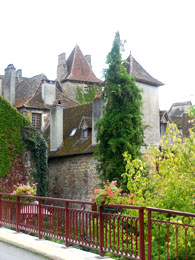 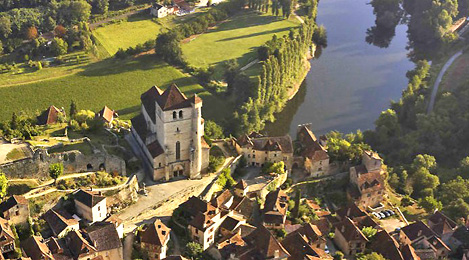 CARENNAC
ST-CIRQ-LAPOPIE
OVERLOOKING THE RIVER LOT
The River Lot is a delight in
itself. Follow it along its winding, 300-mile course as it snakes
its way from its source at Montagne du Goulet in the Cévennes ~ in the region
about which Robert Louis Stevenson wrote Travels With a Donkey in the Cévennes ~ to quite near the town
of Aiguillon where it joins the River Garonne. Along the way you will
find little villages such as St-Eulalie-d'Olt before reaching the
Gorges du Lot, Conques (a bit of a detour south), Cajarc (near the fine
B&B Mas de Garrigue in
Calvignac), St-Cirq-Lapopie, the city of Cahors, very pretty Crayssac,
Puy l'Eveque, and Villeneuve-sur-Lot before ending its journey at the
River
Garonne. The Lot travels through some barely inhabited parts of
the Lozère and Cantal départements and
the river itself is not particularly navigable. But one thing is
certain: the Valley of the Lot is spectacularly beautiful,
peaceful and hardly touched by time. You'll love it! More popular and visited is the département
of Dordogne,
perhaps best known for its perched villages along the river of the same
name and for being a center of prehistory with painted cave dwellings
and other traces of prehistoric man. Three amazing perched
villages and members of Les Plus
Beaux Villages de France are La
Roque Gageac, Beynac-et-Cazenac
and Domme. La Roque-Gageac in the
Périgord-Noir takes advantage of the lovely
Dordogne
River at its base and is a stunning, south-facing village nestled
against a backdrop of forested hillsides. A unique feature of the
village is a troglodyte fort built into the limestone cliffside.
Once accessible by climbing 140 steps, it was closed in 2010 after a
dangerous rockfall, the last of four that took place since 1920.
La Roque Gageac remains one of the most photographed attractions along
the River Dordogne. Beynac-et-Cazenac, populated
since the Bronze Age and just 10 minutes from La Roque Gageac, is rich
in history: it was the French base of
operations against the British who were ensconced across the river in
Château de Castelnaud. Beynac was never captured but was
occupied briefly by Richard the Lionheart. The village is more
defensive that La Roque Gageac and more open than Domme. The
Château de Beynac at the top of the hillside town was the
property of
the Lords of Beynac until 1962 when it began a 100-year renovation
project under the direction of its new owners. It is one of the
best examples of Medieval château architecture in France and is
worth
your time to visit. You may be interested in visiting the
half-ruined Château de Commarque owned by the last member of the
Lords
of Beynac, Hubert de Commarque. Individual and group tours can be
arranged, and if you are a guest in one of his two Périgord
châteaus, Château
de la
Poujade or Château
de la Bourgonie, the tours are included in your stay. You can enter the fortified bastide
town of Domme ~ built in
the 13th century during the Albigensian Crusade by King Philippe III ~
by walking through a
massive arched gateway to find yourself in a grand square surrounded by
little shops and casual restaurants. It's situated on a high
cliff
overlooking the Dordogne Valley, from where you can see the nearby
towns of La Roque Gageac and Beynac-et-Cazenac. 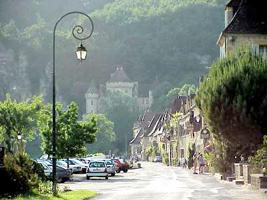 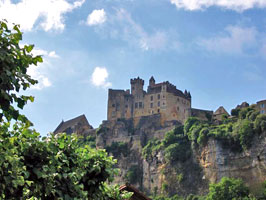 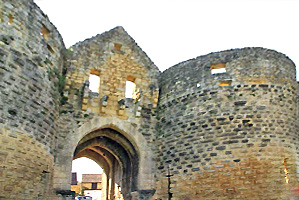
LA ROQUE GAGEAC
BEYNAC-ET-CAZENAC
DOMME
MONPAZIER MARKET DAY
LIMEUIL
Limeuil
is a fairytale Medieval village at the confluence of the Dordogne and
Vézère Rivers and offers travelers a glimpse into village
life on the
river 800 years ago. Because it was fortunate to be located where
two major rivers met, Limeuil benefited greatly from river
trade. Its church is Sainte-Catherine, named after the patron
saint of boat people. Lovely Romanesque buildings and three of
the four original entrance gates are still standing. The hillside
behind the village is the site of the chateau ~ Limeuil was
embroiled in the Hundred Years War and had to defend itself
during a war that actually went on for 116 years. As with many
villages and sites in the Dordogne, especially near the River
Vézère,
Limeuil traces its first inhabitants back 12,000 to 15,000 years ~ to the Magdalenian VI period ~ judging by the dating of carvings of
animals on the walls of the cave near the river. At
this
point, we would like to give a tip on driving in France.
St-Robert
is another Corrèze
village your may find interesting: a village arranged around a
Benedictine monastery built in the 11th century. It is high
above a valley with endless views to the north and toward the Dordogne
just to the south. It is hard to imagine that this small,
peaceful town was the scene of violent religious clashes that
miraculously
left the 12 century Romanesque church [see photo below]
and the rich architectural heritage of the village houses intact.
Each August 15th the village is the site of a pilgrimage ~ the pilgrims
gather around a 'magic' fountain below the town. Our favorite
place to spend a few days is Château du Bois
Noir, a short drive from St-Robert, and a lovely bed and breakfast
with spectacular panoramic views of the countryside.
ST-ROBERT
Not listed as one of the Most
Beautiful Villages of France is tiny Montrol-Senard
reached from Mortemart just above the village. It is a designated
Village Fleuri [Label de
Qualité de Vie], now being held by 4700 French communes,
and it
certainly does deserve it. Walk through town and find flowers
displayed in hanging baskets, on fences and in the landscaping.
The entire village is an ecomusée,
so in addition to tourists visiting the lovely church,
eco-tours are now available to them ~ and with the help of donations
and volunteers the tour now includes 17 interesting village sites.
ENTERING MONTROL-SENARD
CHÂTEAU DE MORTEMART Burgundy is a great vacation
destination. There is much to see and do, including visits to
wine producers and simply enjoying the beautiful Burgundian
countryside. Two départements we will visit are the Côte
d'Or and the Yonne.
Beginning in the Côte d'Or, we must first say
that this is important Burgundy wine country ~ the Gold Coast ~ a
limestone escarpment which includes Côte de Nuits to the north
and Côte de Beaune at the southern end. Among the wines
produced in this region are Mersault, Pommard, Gevrey-Chambertin,
Montrachet and Clos de Vougeot. It
is also here you can see the source of the River Seine if you are so
inclined. You may be as surprised as we were to
see that this
important 483 mile-long commercial waterway begins with the tiniest
spring in a cave in the Côte d'Or as shown in the photo on our
first page. Château
de Chorey, a once famous producer of Côte-de-Beaune wine,
offers elegant bed and breakfast accommodations. One of the Most Beautiful
Villages of France in this département is Flavigny-sur-Ozerain, made famous by the 2000 movie Chocolat starring Juliette Binoche
and Johnny Depp. The majority of the film was made here, but 5
other French locations were used including Noyers-sur-Serein and
Beynac-et-Cazenac.
Flavigny-sur-Ozerain is
a Medieval village surrounded by three
small rivers, one of which is the Ozerain. A Benedictine abbey
was founded on the site in the year 719, and the town received relics
of Sainte Reine from the nearby town of Alise to protect the
relics from
frequent Viking raids. The relics remain in Flavigny to this
day. In the 18th century a home for the Abbot of Flavigny was
constructed, and today it is the home to a factory for the village
specialty: Les Anis de Flavigny,
small aniseed-flavored pastilles sold around the world.
A forty-minute drive south will
take you to Châteauneuf-en-Auxois,
another of this département's
Most Beautiful Villages. It is high on a rocky spur still keeping watch
over the route between Dijon and Autun, and is considered one of the
last examples of 14th century military architecture in France.
During the Hundred Years War towers and walls were built to defend the
Auxois plain. It was a prosperous town between the 14th and 17th
centuries, and many wealthy merchants built houses in
Châteauneuf, many of which still survive today.
CHÂTEAUNEUF-EN-AUXOIS
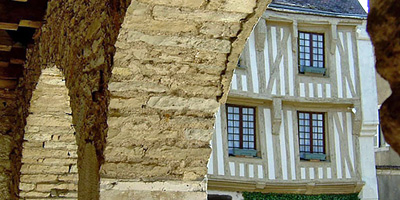 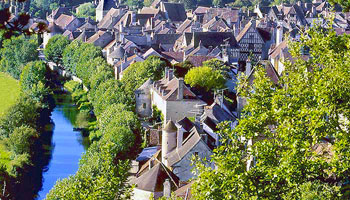 NOYERS-SUR-SEREIN 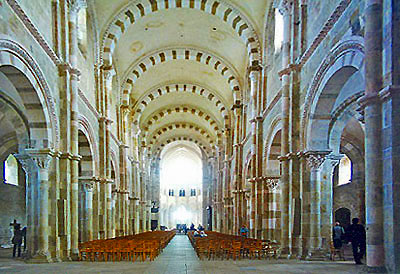 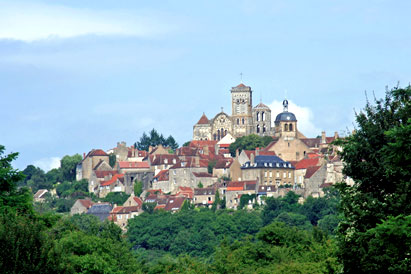 The second village in the Yonne département that
we recommend is Vézelay,
high above the valley, and best known for the
11th century Romanesque Basilica of Sainte-Magdalene. Both the
abbey and the town are UNESCO World Heritage Sites. The second village in the Yonne département that
we recommend is Vézelay,
high above the valley, and best known for the
11th century Romanesque Basilica of Sainte-Magdalene. Both the
abbey and the town are UNESCO World Heritage Sites. It is said that relics from Mary Magdalene were brought to the abbey before the end of the first millennium by a monk, and they were authenticated in 1058 by Pope Stephen IX which began what, to this day, has made Vézelay a pilgrimage site. It is also the starting point for pilgrims traveling the Way of Santiago de Compostela (Saint Jacques de Compostelle). You may want to follow the River Yonne as it wanders through Burgundy. It has its source at Château Chinon in the massif known as the Morvan. It flows north through Villeneuve-sur-Yonne, Joigny, Clamecy and the city of Auxerre. It is a lovely river with little traffic, many portions 'canalized', before emptying into the Seine at Montereau-Fault-Yonne in the Seine-et-Marne département. Stay in the Yonne at La Borde Maison d'Hôtes, Château de Resle, or Le Petit Manoir des Bruyères for exceptional B&B lodging, and the Château de Vallery is a large estate that specializes in hosting weddings and group events.  On the northeastern edge of France is Alsace, a long-disputed region that has gone back and forth between France and Germany several times. Now, solidly part of France, one département in Alsace is the Haut-Rhin where you will find the charming and lively village of Riquewihr. The wines produced in this region are primarily white such as Rieslings and Gewürztraminer. The Vosges mountains to the west and the Rhine River to the east have a great influence over the climate with the mountains shielding the narrow, north to south growing area from westerly winds leaving the area dry and sunny. Riquewihr itself maintains its 16th century feeling and has been a trading hub over the centuries. Fortunately, it suffered little damage during World War II. 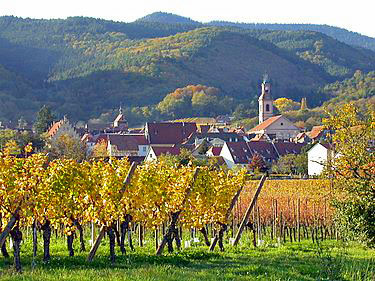 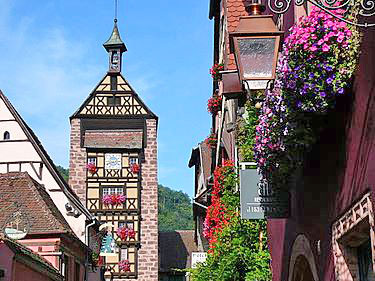 CHARMING RIQUEWIHR
continued
on page 4
|